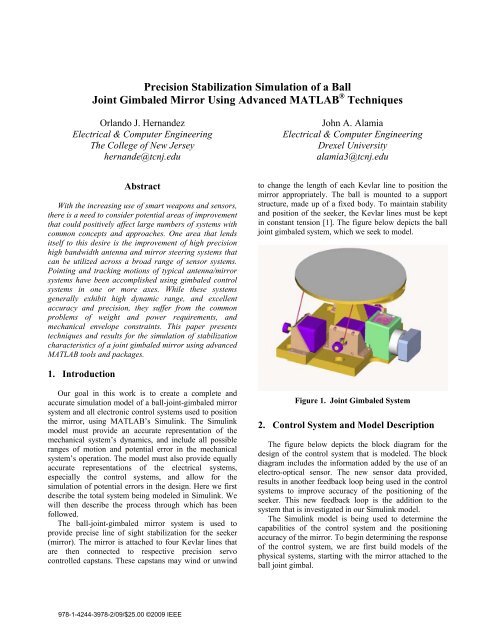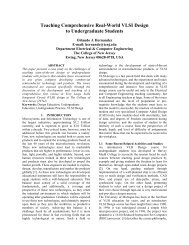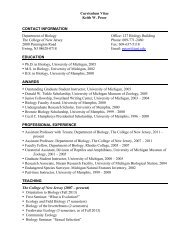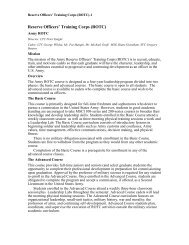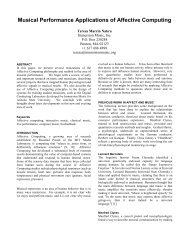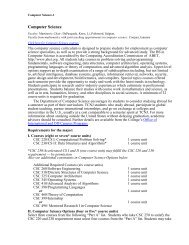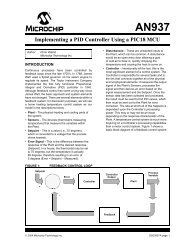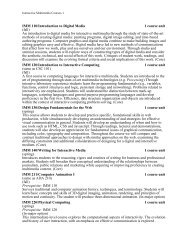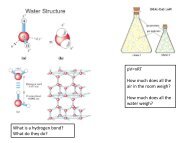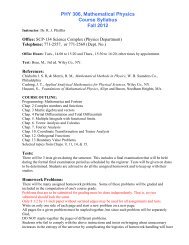Precision Stabilization Simulation of a Ball Joint Gimbaled Mirror ...
Precision Stabilization Simulation of a Ball Joint Gimbaled Mirror ...
Precision Stabilization Simulation of a Ball Joint Gimbaled Mirror ...
Create successful ePaper yourself
Turn your PDF publications into a flip-book with our unique Google optimized e-Paper software.
<strong>Precision</strong> <strong>Stabilization</strong> <strong>Simulation</strong> <strong>of</strong> a <strong>Ball</strong><br />
<strong>Joint</strong> <strong>Gimbaled</strong> <strong>Mirror</strong> Using Advanced MATLAB ® Techniques<br />
Orlando J. Hernandez<br />
Electrical & Computer Engineering<br />
The College <strong>of</strong> New Jersey<br />
hernande@tcnj.edu<br />
John A. Alamia<br />
Electrical & Computer Engineering<br />
Drexel University<br />
alamia3@tcnj.edu<br />
Abstract<br />
With the increasing use <strong>of</strong> smart weapons and sensors,<br />
there is a need to consider potential areas <strong>of</strong> improvement<br />
that could positively affect large numbers <strong>of</strong> systems with<br />
common concepts and approaches. One area that lends<br />
itself to this desire is the improvement <strong>of</strong> high precision<br />
high bandwidth antenna and mirror steering systems that<br />
can be utilized across a broad range <strong>of</strong> sensor systems.<br />
Pointing and tracking motions <strong>of</strong> typical antenna/mirror<br />
systems have been accomplished using gimbaled control<br />
systems in one or more axes. While these systems<br />
generally exhibit high dynamic range, and excellent<br />
accuracy and precision, they suffer from the common<br />
problems <strong>of</strong> weight and power requirements, and<br />
mechanical envelope constraints. This paper presents<br />
techniques and results for the simulation <strong>of</strong> stabilization<br />
characteristics <strong>of</strong> a joint gimbaled mirror using advanced<br />
MATLAB tools and packages.<br />
to change the length <strong>of</strong> each Kevlar line to position the<br />
mirror appropriately. The ball is mounted to a support<br />
structure, made up <strong>of</strong> a fixed body. To maintain stability<br />
and position <strong>of</strong> the seeker, the Kevlar lines must be kept<br />
in constant tension [1]. The figure below depicts the ball<br />
joint gimbaled system, which we seek to model.<br />
1. Introduction<br />
Our goal in this work is to create a complete and<br />
accurate simulation model <strong>of</strong> a ball-joint-gimbaled mirror<br />
system and all electronic control systems used to position<br />
the mirror, using MATLAB’s Simulink. The Simulink<br />
model must provide an accurate representation <strong>of</strong> the<br />
mechanical system’s dynamics, and include all possible<br />
ranges <strong>of</strong> motion and potential error in the mechanical<br />
system’s operation. The model must also provide equally<br />
accurate representations <strong>of</strong> the electrical systems,<br />
especially the control systems, and allow for the<br />
simulation <strong>of</strong> potential errors in the design. Here we first<br />
describe the total system being modeled in Simulink. We<br />
will then describe the process through which has been<br />
followed.<br />
The ball-joint-gimbaled mirror system is used to<br />
provide precise line <strong>of</strong> sight stabilization for the seeker<br />
(mirror). The mirror is attached to four Kevlar lines that<br />
are then connected to respective precision servo<br />
controlled capstans. These capstans may wind or unwind<br />
Figure 1. <strong>Joint</strong> <strong>Gimbaled</strong> System<br />
2. Control System and Model Description<br />
The figure below depicts the block diagram for the<br />
design <strong>of</strong> the control system that is modeled. The block<br />
diagram includes the information added by the use <strong>of</strong> an<br />
electro-optical sensor. The new sensor data provided,<br />
results in another feedback loop being used in the control<br />
systems to improve accuracy <strong>of</strong> the positioning <strong>of</strong> the<br />
seeker. This new feedback loop is the addition to the<br />
system that is investigated in our Simulink model.<br />
The Simulink model is being used to determine the<br />
capabilities <strong>of</strong> the control system and the positioning<br />
accuracy <strong>of</strong> the mirror. To begin determining the response<br />
<strong>of</strong> the control system, we are first build models <strong>of</strong> the<br />
physical systems, starting with the mirror attached to the<br />
ball joint gimbal.<br />
978-1-4244-3978-2/09/$25.00 ©2009 IEEE
Figure 2. Block Diagram <strong>of</strong> Control Systems and<br />
Motor Control<br />
The ball-joint gimbal mirror Simulink model has been<br />
divided into four main systems, the digital signal<br />
processing, servo-capstan operation, the Kevlar rope<br />
behavior, and mirror’s physical behavior. The digital<br />
signal processing model calculates the final length <strong>of</strong> the<br />
Kevlar ropes for a given desired mirror orientation. The<br />
Simulink blocks used in this system can be seen in the<br />
figure below.<br />
The calculation to determine the final length <strong>of</strong> the<br />
Kevlar ropes is done by first converting the angles that<br />
have been entered as the input to a direction cosine matrix.<br />
The angles entered must be given in radians for the<br />
direction cosine matrix to be properly calculated. The<br />
direction cosine matrix provides a complete mathematical<br />
description <strong>of</strong> the mirror’s orientation. The direction<br />
cosine matrix is then operated on to determine the<br />
location <strong>of</strong> the holes in the mirror to which the Kevlar<br />
ropes are attached. The current coordinates <strong>of</strong> the hole in<br />
the mirror’s new orientation is determined by multiplying<br />
the direction cosine matrix with a diagonal matrix<br />
containing the initial coordinates <strong>of</strong> the hole. This process<br />
is summarized by the equations below where the first<br />
matrix is the direction cosine matrix, and the second is a<br />
diagonal matrix <strong>of</strong> the holes’ initial coordinates.<br />
Figure 3. Simulink System Used to Calculate Final Rope Length<br />
To determine the final coordinates <strong>of</strong> the hole in the<br />
mirror each row must be summed, producing the X, Y,<br />
and Z coordinates in the first, second and third rows<br />
respectively. The initial positions <strong>of</strong> the holes are<br />
determined from a Pro/Engineer model <strong>of</strong> the ball-joint<br />
gimbal mirror at 0 degrees azimuth and 0 degrees<br />
elevation. The coordinates where the rope meets the<br />
capstan, also determined from the Pro/Engineer model <strong>of</strong><br />
the ball-joint gimbal mirror, is then subtracted from the<br />
coordinates calculated previously. The magnitude <strong>of</strong> this<br />
vector is then calculated to produce the distance between<br />
the two points, giving us our final rope length. To avoid<br />
initialization <strong>of</strong> the rope lengths, which may be seen as a<br />
large disturbance by the system, the initial length <strong>of</strong> the<br />
rope is subtracted from the commanded position, yielding<br />
the change in rope length from the initial position as the<br />
command received by the control system.<br />
To determine the lengths <strong>of</strong> the ropes from the optical<br />
encoders in the capstans we use the measure <strong>of</strong> the angle<br />
provided and multiply it by the radius <strong>of</strong> the capstan. This<br />
yields the length <strong>of</strong> rope that has been wound, or in the<br />
case <strong>of</strong> a negative angle, unwound, from the capstan.<br />
There is also no initialization added to the optical encoder,<br />
resulting in the output being the change in rope length<br />
from the initial position’s appropriate rope lengths.<br />
⎡uˆ<br />
⎢<br />
⎢<br />
uˆ<br />
⎢⎣<br />
uˆ<br />
x<br />
y<br />
z<br />
vˆ<br />
x<br />
vˆ<br />
y<br />
vˆ<br />
z<br />
wˆ<br />
x ⎤ ⎡X<br />
i<br />
wˆ<br />
⎥<br />
×<br />
⎢<br />
y<br />
⎥ ⎢<br />
0<br />
wˆ<br />
⎥⎦<br />
⎢<br />
z ⎣ 0<br />
0<br />
Y<br />
i<br />
0<br />
0 ⎤ ⎡X<br />
⎢<br />
0<br />
⎥<br />
⎥<br />
= ⎢ Y<br />
Z ⎥⎦<br />
⎢<br />
i ⎣ Z<br />
xx<br />
yx<br />
zx<br />
X<br />
Y<br />
Z<br />
xy<br />
yy<br />
zy<br />
X<br />
X<br />
Z<br />
xz<br />
yz<br />
zz<br />
⎤<br />
⎥<br />
⎥<br />
⎥<br />
⎦<br />
(1)<br />
The information from the optical controller is dealt<br />
with in the same fashion as the input command. The<br />
angles measured by the sensor are first converted to a<br />
direction cosine matrix, and then through the calculations<br />
previously mentioned the lengths <strong>of</strong> the ropes are<br />
calculated and sent to the control system, which can be<br />
seen in Figure 4.<br />
The resulting signal from the control system is sent to<br />
the servomotor-capstan system. The servomotor accepts<br />
the signal and uses a lookup table to determine the<br />
position the command given by the digital signal
processing system, corresponds to. The position is then<br />
used to supply the electrical model <strong>of</strong> the servomotor with<br />
a voltage proportional to the difference in current position<br />
and commanded position. The Simulink blocks used to<br />
create the model <strong>of</strong> the servomotor can be seen in Figure<br />
5. The model <strong>of</strong> the servomotor assumes that the servo is<br />
powered by a 5-volt source whose polarity may be<br />
reversed to spin the servomotor in the opposite direction.<br />
Figure 4. Simulink Model <strong>of</strong> Control System<br />
Figure 5. Simulink Model <strong>of</strong> a Servo Motor<br />
The mechanical components <strong>of</strong> the servomotor are<br />
modeled as a rotating mass with a torque proportional to<br />
the current through the electrical model. The angles <strong>of</strong> the<br />
servomotor, as well as the current through the electrical<br />
model, are sent to analog to digital converters, and the<br />
torque is sent to the Kevlar rope system <strong>of</strong> the model.<br />
The torque <strong>of</strong> the capstan is converted to a force vector<br />
applied to the mirror. The force vector is calculated by<br />
determining the unit vector, which points from the<br />
capstan to the hole on the mirror to which the rope is<br />
attached. The magnitude <strong>of</strong> the torque is then multiplied<br />
through the unit vector, resulting in the appropriate force<br />
vector, which is then passed to the mechanical model <strong>of</strong><br />
the mirror. The calculation <strong>of</strong> the force vector can be seen<br />
in Figure 6. The calculation <strong>of</strong> the force vector in Figure 6<br />
assumes that there is no change in the length <strong>of</strong> the rope<br />
while under tension and that the line never becomes slack.<br />
The three force vectors calculated through this fashion<br />
are applied to the mechanical model <strong>of</strong> the mirror, which<br />
can be seen in Figure 7. The model applies the forces at<br />
the appropriate point on the mirror, which is mounted on<br />
a spherical joint. The mirror is modeled as a body placed<br />
on top <strong>of</strong> a spherical joint that is connected to an object<br />
fixed in space.
Figure 6. Conversion <strong>of</strong> Capstan Torque to Force Vector<br />
Figure 7. SimMechanics Physical Model <strong>of</strong> <strong>Mirror</strong> and <strong>Ball</strong> <strong>Joint</strong> Gimbal<br />
3. <strong>Simulation</strong>s and Results<br />
A simulation was created to obtain data to compare the<br />
behavior <strong>of</strong> the servomotors alone, both with and without<br />
the optical sensor. Through this simulation, we are able to<br />
infer the approximate benefits <strong>of</strong> the optical sensor. To<br />
make the comparison eight simulations were created to<br />
allow for comparison in both time and frequency domain<br />
responses. The first four simulations are time domain<br />
representations, first a step response, followed by a step<br />
response that is then moved to a second position before<br />
returning to its initial position. In both <strong>of</strong> these cases the
simulation was run with and without the optical sensor,<br />
yielding the four time domain simulations. The next four<br />
simulations were done in the frequency domain yielding<br />
the frequency response <strong>of</strong> the servo system under the four<br />
conditions used in the time domain analysis.<br />
In the simulations involving the optical sensor, as<br />
depicted below, the inaccuracy <strong>of</strong> the optical sensor was<br />
used to calculated the expected steady state error, which<br />
was then added into the model in the same fashion as the<br />
steady state error previously expected according to the<br />
measured results. The steady state error <strong>of</strong> the servo was<br />
calculated by determining the inaccuracy the servomotor<br />
experience because <strong>of</strong> the inaccuracy in mirror position<br />
measurement.<br />
Figure 8. Control System Block <strong>of</strong> Servo Simulink Model<br />
Using this model, we were able to produce the results<br />
previously mentioned. The first is the time domain step<br />
response <strong>of</strong> the servomotor without the optical device.<br />
This can be seen below, where the top graph is the<br />
position, and the bottom graph is the error in position.<br />
The next simulation uses the optical sensor. The<br />
resulting graphs may be seen in Figure 10. When the<br />
optical sensor is added the steady state error shrinks to<br />
approximately 50μradians, compared to the 400μradians<br />
seen in the simulation seen previously in Figure 9.<br />
Figure 9. Step Response <strong>of</strong> Servo without Optical Sensor
Figure 10. Step Response <strong>of</strong> Servo with Optical Sensor<br />
Figure 11. Double Step Response <strong>of</strong> Servo with Optical Sensor<br />
4. Conclusions<br />
The simulation results <strong>of</strong> both the time domain and<br />
frequency domain support the expected results. The<br />
relative benefits shown in the servomotor control will be<br />
seen in the total system. The addition <strong>of</strong> the optical sensor<br />
greatly improves the steady state error, as well as<br />
bandwidth and magnitude responses. The simulation<br />
model also allows the optical sensor accuracy to be<br />
altered to different specifications in the future.<br />
5. Acknowledgements<br />
This work was accomplished thanks to the financial<br />
support <strong>of</strong> a grant from the US Navy Naval Air Warfare<br />
Center Weapons Division STTR grant N07-T007 under<br />
Contract Number: N00014-07-M-0446.<br />
6. References<br />
[1] Christison, Donald, et al; <strong>Ball</strong> <strong>Joint</strong> Gimbal System, US<br />
Patent 6396233, Issued May 28, 2002.


